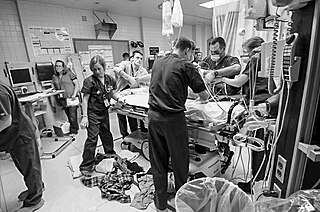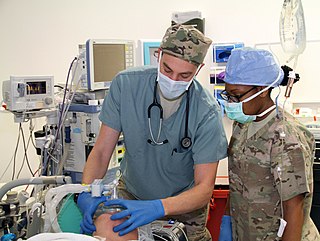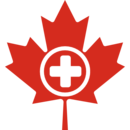A psychiatrist is a physician who specializes in psychiatry. Psychiatrists are physicians and evaluate patients to determine whether their symptoms are the result of a physical illness, a combination of physical and mental ailments or strictly mental issues. Sometimes a psychiatrist works within a multi-disciplinary team, which may comprise clinical psychologists, social workers, occupational therapists, and nursing staff. Psychiatrists have broad training in a biopsychosocial approach to the assessment and management of mental illness.

Emergency medicine is the medical speciality concerned with the care of illnesses or injuries requiring immediate medical attention. Emergency physicians specialize in providing care for unscheduled and undifferentiated patients of all ages. As first-line providers, in coordination with emergency medical services, they are primarily responsible for initiating resuscitation and stabilization and performing the initial investigations and interventions necessary to diagnose and treat illnesses or injuries in the acute phase. Emergency medical physicians generally practice in hospital emergency departments, pre-hospital settings via emergency medical services, and intensive care units. Still, they may also work in primary care settings such as urgent care clinics.
In the medical profession, a general practitioner (GP) or family physician is a physician who treats acute and chronic illnesses and provides preventive care and health education to patients of all ages. GPs' duties are not confined to specific fields of medicine, and they have particular skills in treating people with multiple health issues. They are trained to treat patients to levels of complexity that vary between countries. The term "primary care physician" is more usually used in the US. In Asian countries like India, this term has been replaced mainly by Medical Officers, Registered Medical Practitioner etc.
Internal medicine, also known as general internal medicine in Commonwealth nations, is a medical specialty for medical doctors focused on the prevention, diagnosis, and treatment of internal diseases in adults. Medical practitioners of internal medicine are referred to as internists, or physicians in Commonwealth nations. Internists possess specialized skills in managing patients with undifferentiated or multi-system disease processes. They provide care to both hospitalized (inpatient) and ambulatory (outpatient) patients and often contribute significantly to teaching and research. Internists are qualified physicians who have undergone postgraduate training in internal medicine, and should not be confused with "interns", a term commonly used for a medical doctor who has obtained a medical degree but does not yet have a license to practice medicine unsupervised.

A podiatrist is a medical professional devoted to the treatment of disorders of the foot, ankle, and related structures of the leg. The term originated in North America but has now become the accepted term in the English-speaking world for all practitioners of podiatric medicine. The word chiropodist was previously used in the United States, but it is now regarded as antiquated.

Anesthesiology, anaesthesiology, or anaesthesia is the medical specialty concerned with the total perioperative care of patients before, during and after surgery. It encompasses anesthesia, intensive care medicine, critical emergency medicine, and pain medicine. A physician specialized in anesthesiology is called an anesthesiologist, anaesthesiologist, or anaesthetist, depending on the country. In some countries the terms are synonymous, while in other countries they refer to different positions and anesthetist is only used for non-physicians, such as nurse anesthetists.
A medical school is a tertiary educational institution, professional school, or forms a part of such an institution, that teaches medicine, and awards a professional degree for physicians. Such medical degrees include the Bachelor of Medicine, Bachelor of Surgery, Master of Medicine, Doctor of Medicine (MD), or Doctor of Osteopathic Medicine (DO). Many medical schools offer additional degrees, such as a Doctor of Philosophy (PhD), master's degree (MSc) or other post-secondary education.

The Royal College of Physicians and Surgeons of Canada is a regulatory college which acts as a national, nonprofit organization established in 1929 by a special Act of Parliament to oversee the medical education of specialists in Canada.

Podiatry, or podiatric medicine and surgery, is a branch of medicine devoted to the study, diagnosis, and treatment of disorders of the foot and ankle. The healthcare professional is known as a podiatrist. The US podiatric medical school curriculum includes lower extremity anatomy, general human anatomy, physiology, general medicine, physical assessment, biochemistry, neurobiology, pathophysiology, genetics and embryology, microbiology, histology, pharmacology, women's health, physical rehabilitation, sports medicine, research, ethics and jurisprudence, biomechanics, general principles of orthopedic surgery, plastic surgery, and foot and ankle surgery.

Residency or postgraduate training is a stage of graduate medical education. It refers to a qualified physician, veterinarian, dentist, podiatrist (DPM) or pharmacist (PharmD) who practices medicine, veterinary medicine, dentistry, podiatry, or clinical pharmacy, respectively, usually in a hospital or clinic, under the direct or indirect supervision of a senior medical clinician registered in that specialty such as an attending physician or consultant. In many jurisdictions, successful completion of such training is a requirement in order to obtain an unrestricted license to practice medicine, and in particular a license to practice a chosen specialty. In the meantime, they practice "on" the license of their supervising physician. An individual engaged in such training may be referred to as a resident, registrar or trainee depending on the jurisdiction. Residency training may be followed by fellowship or sub-specialty training.

The Medical College of Wisconsin (MCW) is a private medical school, pharmacy school, and graduate school of sciences in Milwaukee, Wisconsin. The school was established in 1893 and is the largest research center in eastern Wisconsin. It is associated with Froedtert Hospital as well as Children's Hospital of Wisconsin and houses the Center for Infectious Disease Research There are two additional campuses, one in Green Bay and one in Wausau.

The College of Family Physicians of Canada is a professional association and the legal certifying body for the practice of family medicine in Canada. This national organization of family physicians was founded in 1954 and incorporated in 1968. Although membership is not mandatory to practice medicine, it currently numbers over 38,000 members. Members of the CFPC belong to the national College, as well as to their provincial or territorial chapters. The CFPC uses both English and French as official communication languages.
Podiatric Medical School is the term used to designate the institutions which educate students and train them to be podiatrists, which diagnose and treat conditions affecting the foot, ankle, and related structures of the leg. In the United States, only schools which are accredited by the Council on Podiatric Medical Education (CPME) may earn the status of being a Podiatric Medical School. The Doctor of Podiatric Medicine degree is commonly abbreviated D.P.M. degree. The D.P.M. degree is a prerequisite for an individual to be accepted into a CPME accredited residency. The preparatory education of most podiatric physicians — similar to the paths of traditional physicians — includes four years of undergraduate work, followed by four years in an accredited podiatric medical school, followed by a three- or four-year hospital-based podiatry residency. Optional one- to two-year fellowship in foot and ankle reconstruction, surgical limb salvage, sports medicine, plastic surgery, pediatric foot and ankle surgery, and wound care is also available.
A medical specialty is a branch of medical practice that is focused on a defined group of patients, diseases, skills, or philosophy. Examples include those branches of medicine that deal exclusively with children (paediatrics), cancer (oncology), laboratory medicine (pathology), or primary care. After completing medical school or other basic training, physicians or surgeons and other clinicians usually further their medical education in a specific specialty of medicine by completing a multiple-year residency to become a specialist.
An international medical graduate (IMG), earlier known as a foreign medical graduate (FMG), is a physician who has graduated from a medical school outside of the country where he or she intends to practice. The term non-local medical graduate may be similarly used in countries with distinct licensing regions within them. Generally, the medical school of graduation is one listed in the World Directory of Medical Schools (WDOM) as accredited by the Foundation for Advancement of International Medical Education and Research or the World Health Organization.
The American Board of Family Medicine (ABFM) is a non-profit, independent medical association of American physicians who practice in family medicine and its sub-specialties. Founded in February 1969 as the American Board of Family Practice (ABFP), the group was the 20th medical specialty to be recognized by the American Board of Medical Specialties and was formed out of a need to encourage medical school graduates to enter general practice. It adopted its current name in 2005.
In Canada, a medical school is a faculty or school of a university that trains future medical doctors and usually offers a three- to five-year Doctor of Medicine (M.D.) or Doctor of Medicine and Master of Surgery degree. There are currently 17 medical schools in Canada with an annual admission success rate normally below 7.5%. As of 2021, approximately 11,500 students were enrolled in Canadian medical schools graduating 2,900 students per year.
Doctor of Osteopathic Medicine is a medical degree conferred by the 38 osteopathic medical schools in the United States. DO and Doctor of Medicine (MD) degrees are equivalent: a DO graduate may become licensed as a physician or surgeon and thus have full medical and surgical practicing rights in all 50 US states. As of 2021, there were 168,701 osteopathic physicians and medical students in DO programs across the United States. Osteopathic medicine emerged historically from osteopathy, but has become a distinct profession.
Pediatric emergency medicine (PEM) is a medical subspecialty of both pediatrics and emergency medicine. It involves the care of undifferentiated, unscheduled children with acute illnesses or injuries that require immediate medical attention. While not usually providing long-term or continuing care, pediatric emergency doctors undertake the necessary investigations and interventions to diagnose patients in the acute phase, to liaise with physicians from other specialities, and to resuscitate and stabilize children who are seriously ill or injured. Pediatric emergency physicians generally practice in hospital emergency departments.
The American Board of Pathology (ABPath) is one of 24 member boards of the American Board of Medical Specialties. This organization was assembled in May 1936, under the approval of the Advisory Board for Medical Specialties (ABMS) and the American Medical Association (AMA) Council on Medical Education and Hospitals. It is the duty of the ABPath to grant certification in Anatomic Pathology, Clinical Pathology and/or Anatomic/Neuropathology to qualified Doctors of Medicine and Doctors of Osteopathic Medicine (M.D./D.O.).










